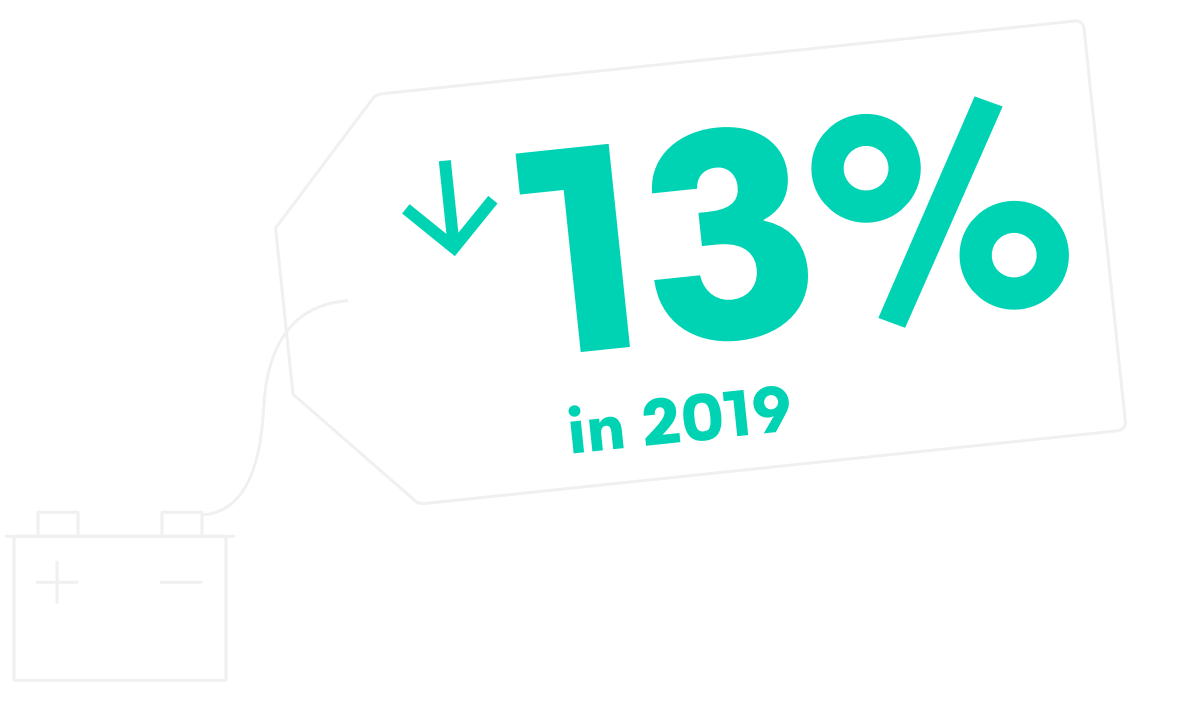Electric
Vehicle
Outlook
2020

The Electric Vehicle Outlook is BloombergNEF’s annual long-term forecast of how electrification, shared mobility and autonomous driving will impact road transport from now out to 2040. It covers light duty passenger vehicles, commercial vehicles, buses, and two/three-wheeled vehicles. The report draws on our team of specialists around the world and looks at how these trends will impact the automotive, energy, infrastructure, and battery materials markets over the next 20 years.
Findings
Number of EV models available
Automakers are accelerating their EV launch plans, partly to comply with increasingly stringent regulations in Europe and China. COVID-19 will delay some of these, but by 2022 there will be over 500 different EV models available globally. Consumer choice and competitive pricing will be key to attracting new buyers to the market.
EV sales
Passenger EV sales jumped from 450,000 in 2015 to 2.1 million in 2019. They will drop in 2020 before continuing to rise as battery prices fall, energy density improves, more charging infrastructure is built, and sales spread to new markets.
EV share of new car sales
The electric share of total vehicle sales is still small, but it is rising fast. By 2040, over half of all passenger vehicles sold will be electric. Markets like China and parts of Europe achieve much higher penetrations, but lower adoption in emerging markets reduces the global average.
Size of the global EV fleet
Electric vehicles become an increasingly common sight in the years ahead. Battery electric vehicles account for the majority of these, but plug-in hybrids also play a role over the next ten years before fading as pure electrics continue to get cheaper.
Global vehicle fleet
Despite the rapid growth, there will be 1.4 billion passenger vehicles on the road in 2030 and EVs account for just 8% of these. This rises to 31% by 2040 as the fleet slowly changes over.
China’s share of global EV sales
China accounts for the largest share of global EV sales as it looks to reduce energy imports, clean up urban air quality, build its domestic auto industry, and attract manufacturing investment.
Share of total kilometers in shared mobility applications
Shared mobility usage drops in 2020 as COVID-19 pushes people into private cars, but by 2040 it represents 16% of all kilometers travelled by road. Autonomous vehicles progress steadily but do not materially impact global travel patterns until the latter half of the 2030s.
Factors driving the market
![]()
Technology
Batteries keep getting better. Average battery energy density is rising at 4-5% per year and new chemistries are hitting the market. Maximum EV charging speeds are also rising.
![]()
Policy
Policymakers are pushing the auto market towards lower emissions. Fuel economy regulations, quota systems and city policies all play a growing role.
![]()
Economics
By the mid-2020s EVs reach up-front price parity – without subsidies – with internal combustion vehicles in most segments, but there is wide variation by region.
![]()
Companies
Automakers and large fleet operators are accelerating their investments in electrification as part of their long-term climate commitments, and to meet near-term policy requirements.
Falling lithium-ion battery prices
Lithium-ion battery pack prices fell 87% from 2010 to 2019, with the volume-weighted average hitting $156/kWh. Underlying material prices will play a larger role in the future, but the introduction of new chemistries, new manufacturing techniques and simplified pack designs will keep prices falling.


Rising policy pressure
Number of countries that have announced plans to phase out sales of internal combustion vehicles.
13
Countries
31
Cities/Regions
Which segments will lead?
Looking beyond passenger cars, several ‘killer apps’ are emerging for electrification. Two-wheeled vehicles (scooters, mopeds, motorcycles) and municipal buses are already going electric quickly and accelerate further in the next ten years. Delivery vans are the next segments to cross the tipping point.
2020
2030
Implications for energy and emissions
Oil demand
EVs across all segments are already displacing 1 million barrels of oil demand per day. Oil demand from passenger vehicles is hit hard by COVID-19 and never recovers to 2019 levels, but growth in heavy commercial vehicles keeps overall road transport oil demand growing until 2031.
![]()
Electricity demand
All those EVs add electricity demand, but not as much as you might think. By 2040 passenger EVs consume 1,290TWh, commercial EVs consume 389TWh, e-buses consume 216TWh and electric two-wheelers consume 69TWh. Combined, these add just 5.2% to global electricity demand. In many advanced economies, EVs prevent overall electricity demand from falling.
![]()
Emissions
EVs and fuel cell vehicles reduce road CO2 emissions by 2.57Gt a year by 2040 – and are set for much larger reductions thereafter – but total emissions are still 6% higher in that year than they were in 2019. More stringent fuel economy regulations for commercial trucks and other policy measures will be needed to bend the curve faster.
![]()
Executive summary
High-level findings of the Electric Vehicle Outlook 2020 are available in the free executive summary below. Click here to see the full list of charts and figures included in the client report.
BNEF Clients
BNEF clients can access the full report, its breakdown by technology and region, as well as the underlying Excel data and previous editions.
Report authors

Colin McKerracher
Lead author
@colinmckerrache

Dr. Ali Izadi-Najafabadi
Vehicle demand
@AI_Energy

Aleksandra O’Donovan
Electric vehicles

Nick Albanese
Shared mobility
@NickRAlbanese

Dr. Nikolas Soulopoulos
Commercial vehicles and freight

David Doherty
Oil impacts

Milo Boers
Modelling

Ryan Fisher
Charging infrastructure

Corey Cantor
Electric vehicles
@CBC727

Dr. James Frith
Batteries
@JamesTFrith

Siyi Mi
China
@siyi_mi

Andrew Grant
Shared mobility
@agrant49
Additional authors:
Alejandro Zamorano-Cadavid, Allen Tom Abraham, Kwasi Ampofo, Nannan Kou, Will Edmonds, Dr. Ian Berryman, Josh Landess, Jinghong Lyu